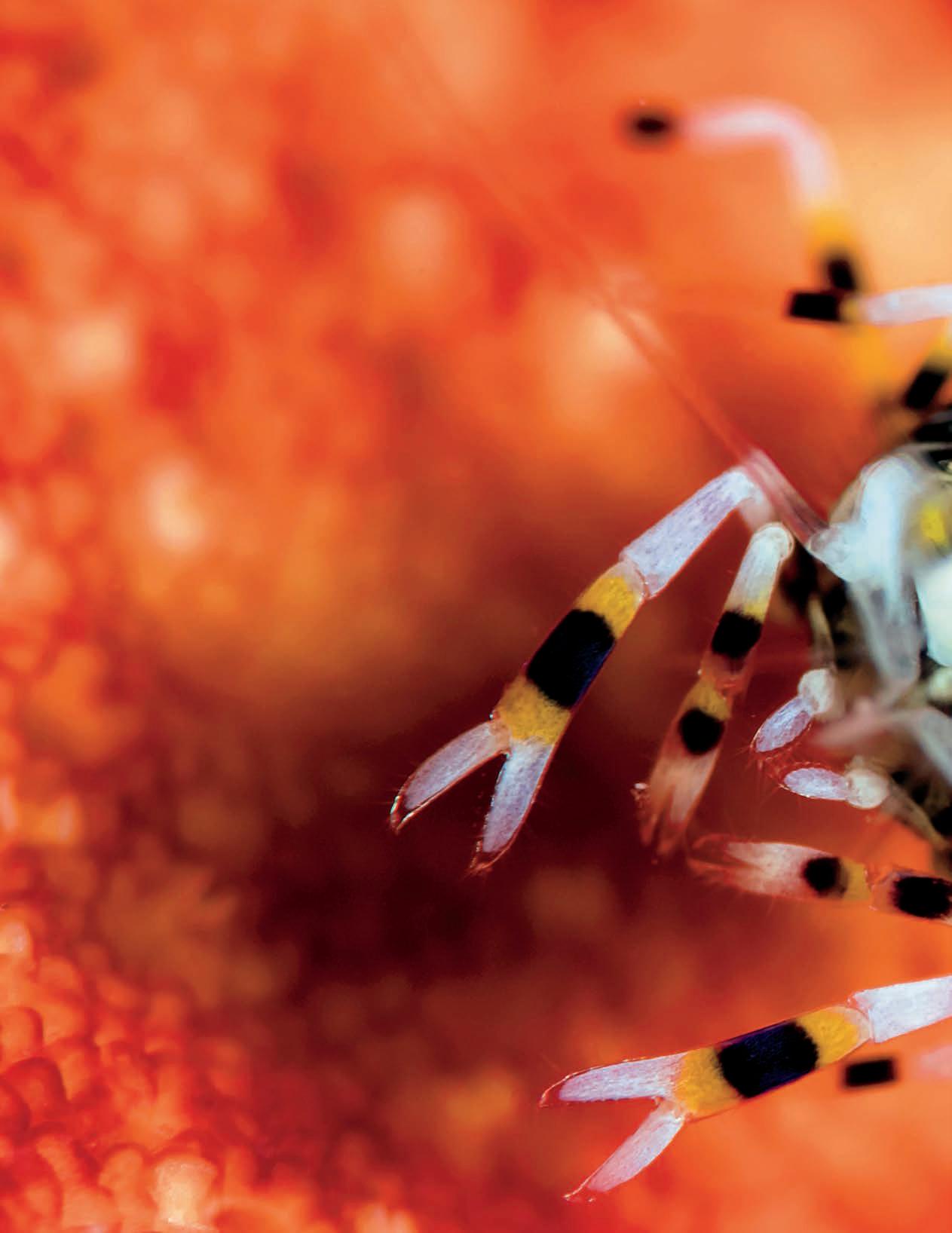
10 minute read
FLORIDA
West Palm Beach’s Blue Heron Bridge might not seem like a diving hotspot, but as Walt Stearns reveals, it is a goldmine for all sorts of weird-and-wonderful marine life
Photography Walt Stearns
Advertisement
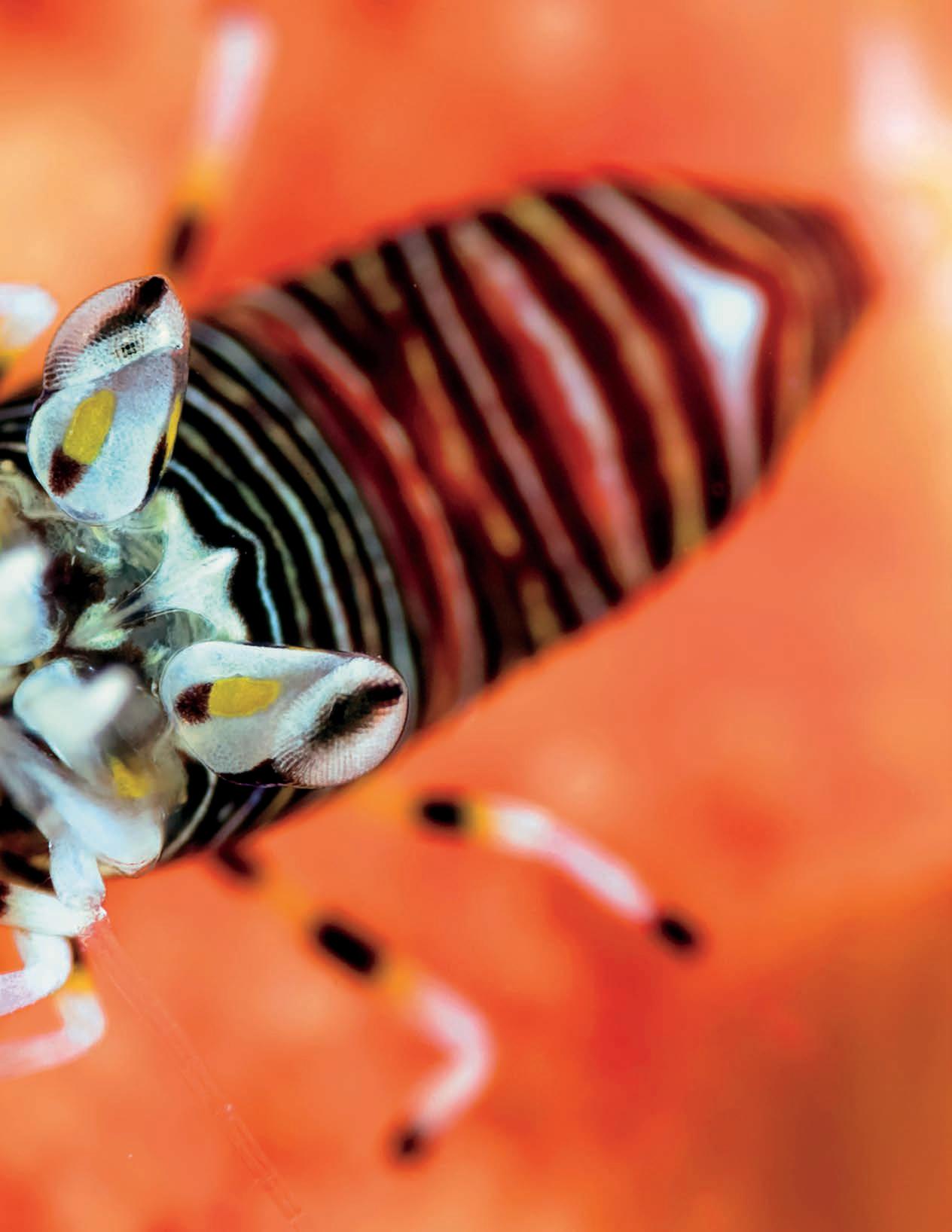
FUN FACT! Palm Beach County boasts nearly 50 miles of shoreline, offering access to more than 20 reef systems for snorkelers and divers.
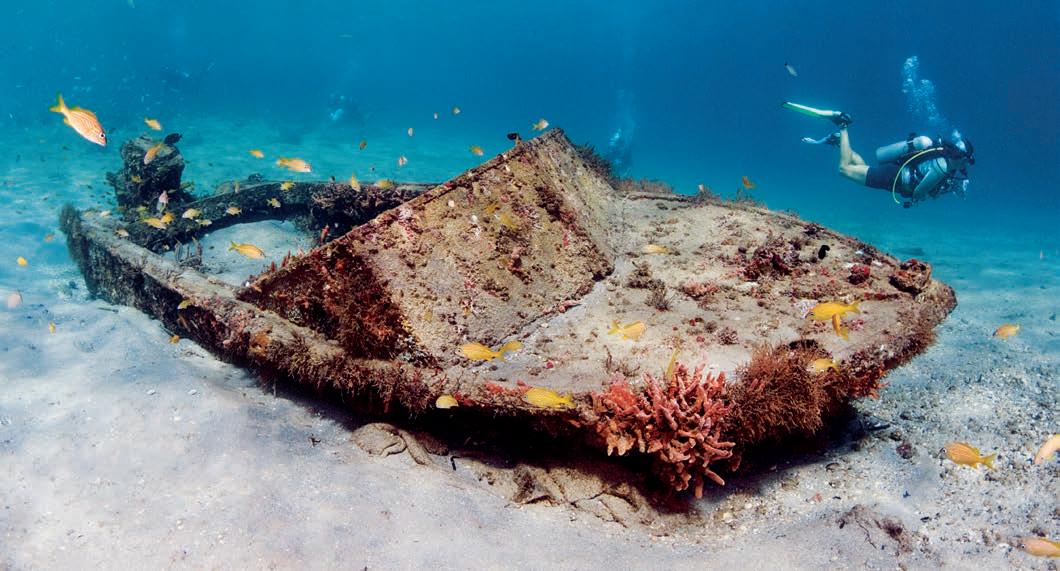
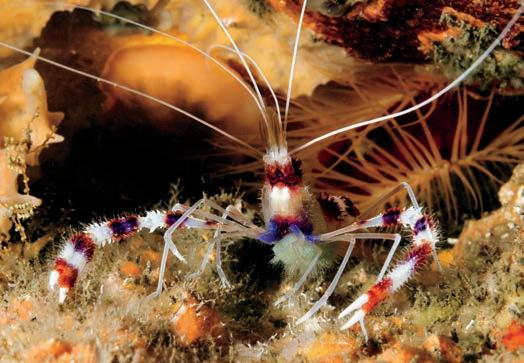
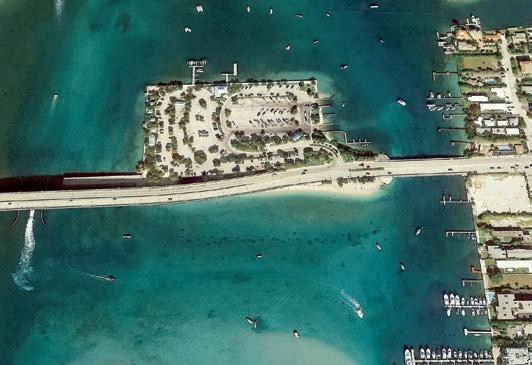
The dive was not going as planned. Fifteen minutes of meticulously scanning the bottom yielded a few interesting subjects like a male pike blenny taking on a territorial stance with its dorsal fin fully erect, and its brilliant neon-bluelined throat pouch extended. But this was not what I had come for this day.
I was on the hunt for another beauty - a striated frogfish (Antennarius striatus). Based on intel from a friend in one of the local dive shops, I hoped to find a resident pair of these elusive and sedentary stealth hunters. A member of the anglerfish family, striated frogfish display a variable range of colors from greenish gray, tan, brown to black, to even a few different shades of yellow and orange. In addition to elongated blotches and stripes running across the body — hence the name — there is the ‘hairy factor’. These fish are generally covered with numerous filaments and tabs across head, body and fins, which gives rise to their other name - the hairy frogfish. In short, I am hunting for a little lumpy-shaped fish
smaller than my fist that looks like it’s dressed in a sniper’s ghillie suit.
Calling a hairy frogfish beautiful, or even handsome, is a bit of a stretch, but their cute factor is hard to ignore. Funnier still is that striated frogfish are not a particularly rare species around West Palm Beach’s Blue Heron Bridge. The problem is, they are gifted with superb camouflaging – thanks to the ghillie suit that helps them blend almost seamlessly into the background.
But for a diver with a keen eye, sometimes all it takes is spotting one in the act of fishing. Like other members of the anglerfish family, the hairy frogfish has a small appendage on their forehead that resembles a worm on the end of a small rod. If you can spot that lure, the jig is up. The other way they will reveal their presence is when the lure draws in a potential meal, at which point the frogfish will make a huge yawning burp that sucks the prey into a gaping mouth. It was one of these big burps that not only revealed one frogfish to me, but also his adjacent buddy. Sorry fellows. You are about to be paparazzied!
The hairy frogfish is covered in spines which resemble strands of hair - hence the name - which allow the animal to camouflage itself against coral and seaweed. Found mostly in warm waters around the world, they can also change color to blend in with their surroundings.
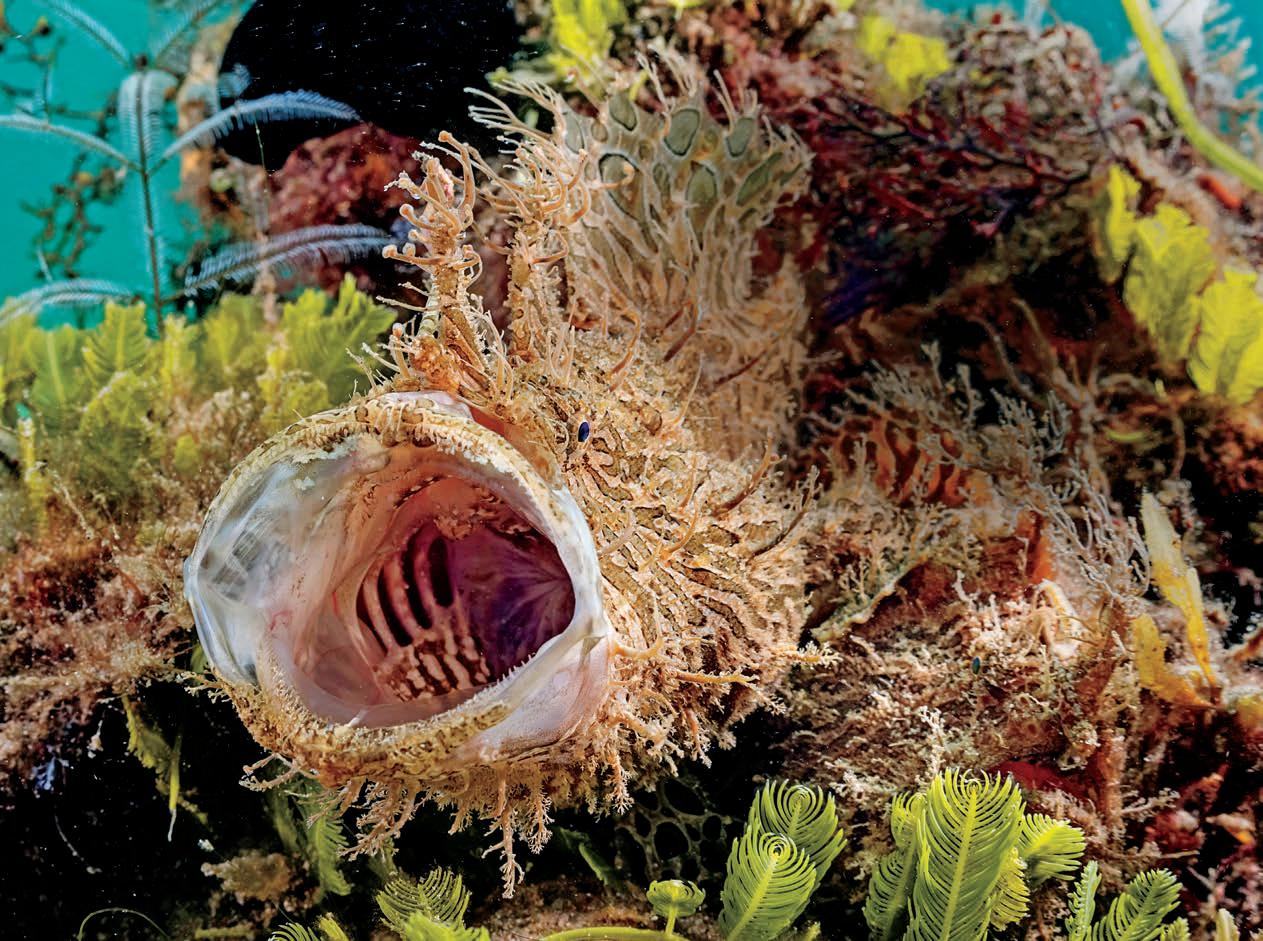
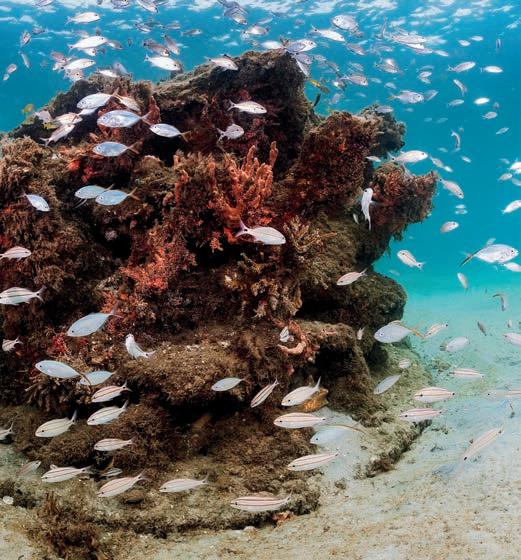
Not much for scenery, but the locals are awesome! As a Palm Beach resident, I can affirm that to really enjoy diving the Blue Heron Bridge is to understand it. The aquatic treasures that await can be rewarding, but finding them can be challenging, and will require a bit of finesse, as the bottom is comprised largely of sand and silt, which can easily get stirred up. To the untrained eye, this ‘mucky’ type of bottom will appear deceptively lifeless. Then you might happen on something that makes you think you are seeing things, like a rather macabre face in the sand that’s looking back up at you. It’s probably a northern stargazer. Bottom-dwelling predators in this region rely on camouflage to avoid advertising their position as they lay in wait to ambush passing prey.
As you move about, further discovery among the sand and rubble reveals more signs of life. Elements such as the occasional empty bottle provide shelter for small octopus or blenny. And then there are the rock piles. In 2012, the city of Riviera Beach placed TOP LEFT There are two small boat wrecks at the bridge
FAR LEFT Aerial view of Blue Heron Bridge
ABOVE LEFT Banded coral shrimp
LEFT Reef module now swarming with marine life
ABOVE Hairy frogfish with jaws agape
more than 600 tons of Anastasia rock boulders in varying sized piles 25 yards out from the beach area at Phil Foster Park, which is the starting point for Blue Heron Bridge diving. Created as a snorkeling trail spanning some 250 yards long in the 6ft-8ft-deep shallows, these structures give divers who are less interested in scouring the sand bottom an alternative, as the rocks host a bevy of fish and invertebrate life. Several years later, the snorkel trail was expanded with the placement of several artificial reef modules. Adding more interest are a pair of small boats that sank at anchor near the bridge. Having been abandoned by their owners right where they sank, they have become foundations for marine growth and habitat for small fish and invertebrates.
Swimming beneath the bridge that connects the West Palm mainland to Singer Island creates a completely different diving experience, as the supporting columns are covered in a hodgepodge of brown, pink and orange-hued sponges, along with patches of bright orange cup corals. Here, divers and snorkelers will find a variety of small crustaceans like arrow crabs and banded coral shrimp, while schools of grunts, immature snapper and spadefish move about feeding in the current.
Taken together, the varying microcosms hold a staggering list of fish and invertebrates. It is for all these reasons that the Blue Heron Bridge is a big draw to underwater macro photographers, to the point of it being regarded as one of the tropical Atlantic’s top-shelf muck-diving destinations. The bridge area is also a protected zone, prohibiting the collection and possession of marine life within the park and surrounding waters. The only activity currently not
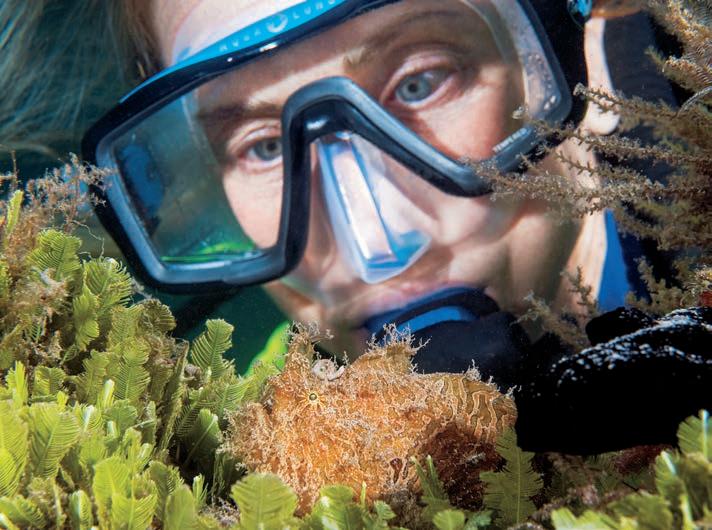
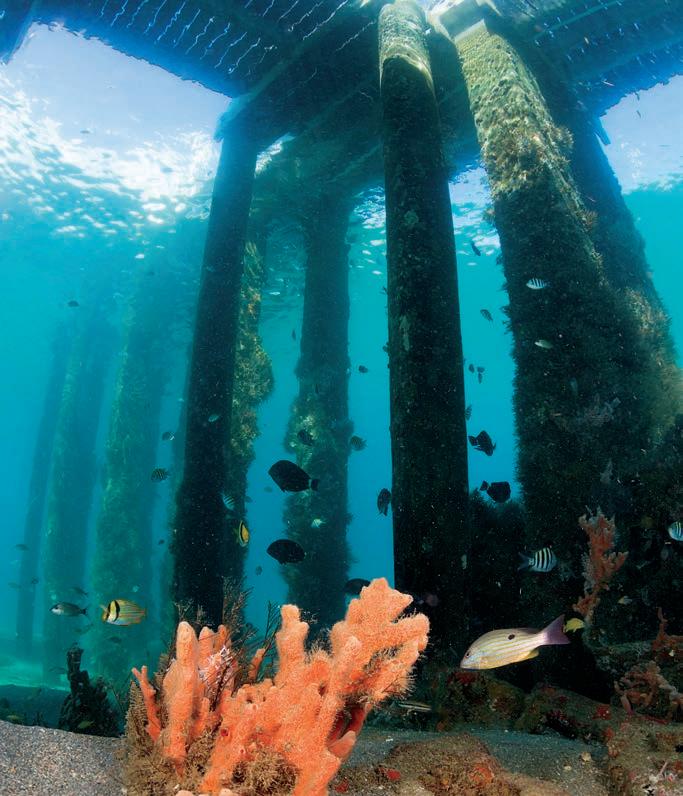
NOT JUST LITTLE CRITTERS While Blue Heron Bridge is rightly famed for its smaller residents, keep an eye out for flypasts from spotted eagle rays, or an encounter with a manatee.
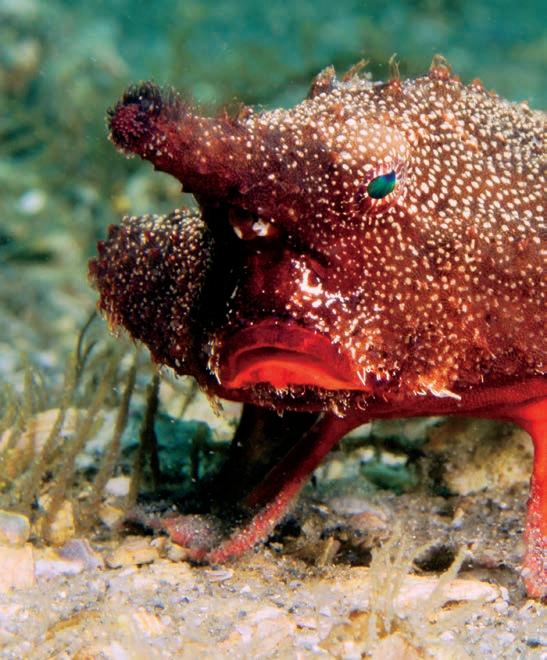

prohibited is recreational hook-and-line fishing from the fishing pier that was the original Blue Heron Bridge. As a Palm Beach resident and frequent bridge diver, I can attest that since the ruling went into effect, success rates on hunts for unique cryptic subjects have gone up. Even more noticeable is the increased presence of juvenile French, grey, blue and queen angelfish, which are found among the bottom’s scattered debris, on lone rock croppings and around bridge pilings.

Ins and Outs of Diving the Bridge The bridge is part of Blue Heron Boulevard, which connects the city of Riviera Beach with Singer Island. Divers coming from the north or south on I-95 should take exit 76 for Blue Heron Boulevard and head east and over the first (larger) span of the bridge over the Intracoastal Waterway. On the backside of the larger span is a lighted intersection where drivers will make a left turn to the entrance for Phil Foster Park.
The park is a small island comprised largely of a parking lot with a boat ramp and docks on the north side, and a small beach on the south side. The mostconvenient spots for accessing the water are along the base of the bridge’s larger span, which is on the southwestern side of the Park.
While parking is free, getting the choicest spot close to the water is a first-come, first-served thing. I can stress the importance of getting there well ahead of your planned dive on weekends and holidays, as the increased number of general beach goers can make finding prime parking more challenging. The entire diveable area of the Blue Heron Bridge is large enough to make it impractical to attempt to cover

Force-E was founded in 1976 by Skip Commagere, and now has three locations in South Florida - Pompano Beach, Boca Raton, and Riviera Beach - which offer superior service to locals and visitors alike, with gas fills, equipment sales and service, and certification courses available across all three stores. Conveniently located less then a mile from the Blue Heron, Force-E Riviera is an easy stop on the way to site. They have a friendly team of knowledgeable locals behind you to ensure you experience some of the best scuba diving in South Florida. Force-E regularly hosts local events including famous Blue Heron Bridge night dives, Gear Demo’s, underwater cleanups, kids events, seminars, fundraisers, parties, and more. www.force-e.com Scuba Centers
TOP TRIO (LEFT TO RIGHT) Support pilings; juvenile French angelfish; bluespotted sea robin
FAR LEFT Hairy frogish
BOTTOM MIDDLE Shortnose batfish
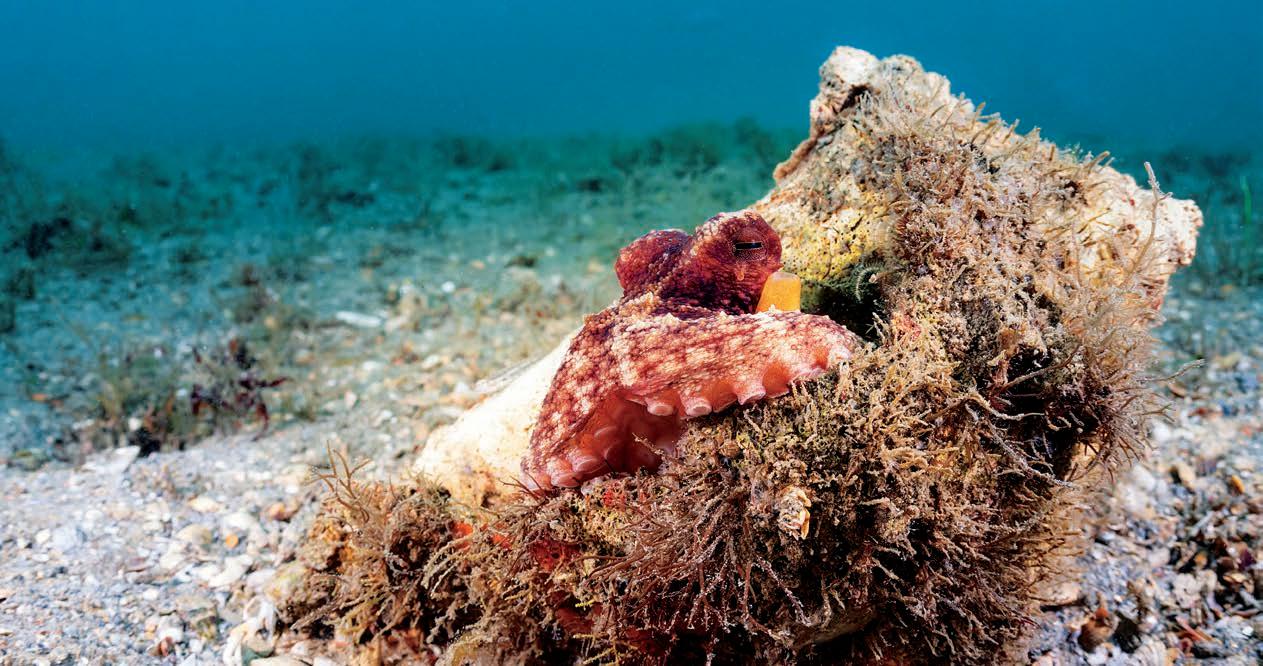
TOP Common octopus
ABOVE Decorator crab

it from end to end in the span of one dive. From a logistical standpoint, the bridge can be divided into three zones.
The first zone covers the region in the shadow of the larger span from the entry point towards the center point of the bridge. This area also includes a section of the original Blue Heron Bridge, which now serves as a local fishing pier. Zone two is the area out front of the beach, which is all flat sand bottom with small grass beds before meeting the Phil Foster Park Snorkeling Trail 25-yards out. To the east towards the small bridge span connecting Phil Foster Park with Singer Island is the third and final zone. This smaller bridge generally has more growth on the pilings than the larger bridge, and it also features the two boat wrecks.
Timing is Everything During most hours of the day, the waters around the foot of West Palm Beach’s Blue Heron Bridge don’t look very enticing, having a muddy-brown hue that is typical for most of Florida’s Intracoastal Waterway. When these conditions prevail, underwater visibility is better measured in inches rather than feet. But, when the incoming tide starts to pour through the Lake Worth Inlet, a transformation takes place and the water becomes clearer and far more inviting. This tide change is the engine that drives the abundance and diversity of marine life found around the bridge, while also providing the best visual window of opportunity. During the final two hours before the peak of the hightide mark, underwater visibility can jump as high as 40 to 50 feet. To know exactly when will require consulting the local tide chart.
Diving anywhere within these three areas could not be easier as the depths never exceed 18ft, but there are a few important things to consider. During the middle phase of the rising tide, it is wise to hold off venturing around the bridge’s pilings under either span as the current can be quite strong. The best time for diving around the bridge pilings is half an hour before the apex of the rising tide, when the current is easier to handle. Timed right, you will be able to enjoy an additional half hour almost current-free before conditions change as the tide reverses course, bringing with it the dirtier waters of the Intracoastal. n
Scuba Centers
17 CHARTER BOATS 3 CONVENIENT LOCATIONS 5 OCEAN INLETS

Snorkel & Dive trips Top Line Rental Gear Local Guides & Instruction Service & Fills
The Locals Underwater Outfitter since 1976. Dive Like a Local.
Force-E Pompano 1312 North Federal HWY Pompano Beach, FL 33062 (954) 943-3483 Force-E Boca Raton 2621 North Federal HWY Boca Raton, FL 33431 (561) 368-0555 Force-E Riviera 155 East Blue Heron Blvd Riviera Beach, FL 33404 (561) 845-2333







